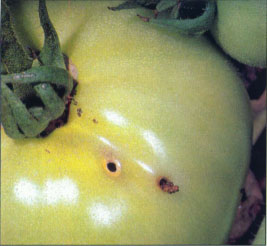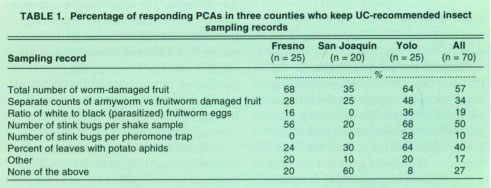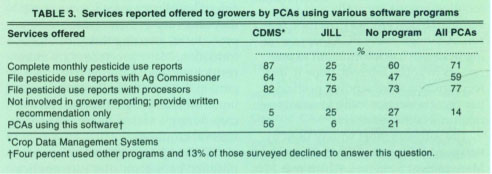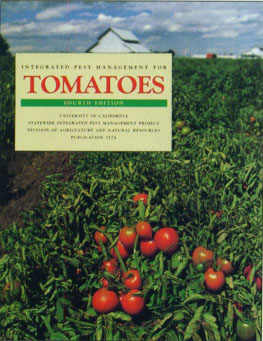All Issues
Pest management record-keeping duties shift with computerization
Publication Information
California Agriculture 52(4):27-31. https://doi.org/10.3733/ca.v052n04p27
Published July 01, 1998
PDF | Citation | Permissions
Abstract
Computer software has been widely adopted in the tomato processing industry for maintaining pest management records. Although computers have not reduced the time necessary to complete record-keeping requirements, they have shifted some of the burden from growers to pest control advisers (PCAs). Most records kept are pesticide use records required by law or by processors, and the legally required written recommendation. There is little evidence that computer software is being used to maintain or analyze field scouting data.
Full text
Many PCAs surveyed said they did not keep records of UC-recommended sampling results, such as monitoring of fruit-worm eggs shown here.
A good integrated pest management (IPM) program requires careful documentation of weather monitoring, crop growth, pest populations, natural enemy numbers, pest control activities and cultural practices; UC IPM publications recommend many monitoring and record-keeping procedures. Although procedures are designed to be both feasible and useful in the field, there is little information on how much of the recommended record keeping is actually done by either pest control advisers (PCAs) or growers, or on what types of pest management records are kept for reference.
In addition to records recommended for IPM decision making, tomato growers and PCAs are required to maintain many records that relate to pest management practices. The California Department of Pesticide Regulation (CDPR) requires records of pesticide use, consideration of alternatives, safety training information and environmental considerations. Processors require detailed documentation of pesticide use, and different processor companies have different forms and reporting procedures. Currently all of these requirements involve different forms, documentation and procedures.
PCAs were more likely to keep records of sampling for worm-damaged fruit than any other UC-recommended sampling method. The frass emerging from one of these holes suggests the damage was caused by tomato fruitworm rather than army-worm.
A major goal of this project was to determine what types of records growers and PCAs keep and which records they consider essential or useful in their pest management programs, especially in future years. Our hope was to be able to suggest some ways to streamline the ever-increasing paperwork required in today's agriculture and to gain insight into the feasibility of various record-keeping procedures. We chose processing tomatoes as an example for several reasons, including the strong interest processors have in pesticide records; the availability of several University of California publications suggesting pest monitoring techniques and record forms; and the willingness of processing tomato growers, PCAs and processors to cooperate in such a study.
Mail survey
A mail survey was used to determine what pest management records are currently kept by processing-tomato PCAs and growers in three major California processing-tomato production counties (Fresno, San Joaquin and Yolo), and how these records are taken, stored and used over time. Two questionnaires were distributed in the tricounty survey, one for growers and one for PCAs. Grower questionnaires were mailed courtesy of the California Tomato Growers' Association (CTGA) to all 249 processing tomato growers with a CTGA membership in each of the three counties (76 in Yolo County, 58 in San Joaquin County and 115 in Fresno County). All PCAs in each county who worked in processing tomatoes received surveys, for a total of 109 PCAs (43 in Yolo County, 28 in San Joaquin County and 38 in Fresno County). The mailing list was developed by having farm advisors in each county review the California Agricultural Production Consultants Association (CAPCA) membership list to add PCAs who were not CAPCA members and to eliminate PCAs who did not work in processing tomatoes.
Questionnaire content related to what records were kept, how they were used and what types of additional information or record keeping would be useful. The survey was developed and approved by a project advisory committee. Prior to its distribution, content validity was further established by pretesting. Both questionnaires were 6-page booklets with 23 questions for growers and 20 questions for PCAs. The mail survey was implemented according to the Total Design Method (Dillman 1978), with follow-up mailings.
The mail survey was sent out in April 1996 and yielded the following response rates. The overall PCA response rate was 70% (76/109): Yolo County 60%; San Joaquin County 86%; and Fresno County 68%. The overall grower response rate was 31% (78/ 249): Yolo County 39%; San Joaquin County 26%; and Fresno County 29%. Our ability to follow up on grower nonrespondents was limited by the confidentiality of the mailing list.
Focus groups
The focus group method was used to determine the needs, opinions and concerns of industry stakeholders (growers, PCAs, processors and regulatory agencies) regarding tomato pest management information systems. Focus groups are qualitative, compared to the mail survey method, and they are not intended for statistical inference (Krueger 1994). The focus group process was designed to help identify factors that may not have been identified in the mail survey and to stimulate interactions among participants that would not emerge in individual interviews. Separate focus groups were conducted for PCAs in Yolo County, PCAs in San Joaquin County, PCAs in Fresno County, growers in Yolo County, growers in Fresno County, processors statewide, and regulators statewide. Grower and PCA group participants were obtained from mail survey respondents who indicated an interest in participating (33% of growers and 54% of PCAs). Regulatory agency and processing company participant names were submitted by the project advisory committee.
Questions for focus group participants were developed in conjunction with the project advisory committee and were categorized as follows:
-
How do you like to submit/receive pest management information?
-
What information is useful?
-
Mechanics of pest management record keeping.
-
Communication systems among stakeholder groups.
-
Factors leading to pest management decisions.
-
Level of satisfaction with current information management systems.
Focus group meetings were held during the summer of 1996 in the local area of the stakeholder group and were 90 to 120 minutes in length. Each focus group was facilitated by one project staff member, with another member present to tape record the session and take notes. Following each meeting a full transcript was typed from the tape recording, and focus group summaries were developed from these transcripts.
Results of the survey
Primary records used by PCAs and growers.
The main record that PCAs keep as a reference for decision making in future years is the written recommendation. The written recommendation is the legal document that the CDPR requires all PCAs to keep for 1 year after recommending any pest control treatment. It contains information about the pest being treated, the criteria for suggesting treatment, the recommended pesticide or pest-control procedure and environmental and health considerations, but it does not include field sampling data. Ninety percent of the surveyed PCAs stated that they kept written recommendations for future reference.
Although 73% of the surveyed PCAs stated that they used field report forms, PCAs in focus groups stated that they did not keep more detailed records of pest occurrence in the field such as scouting reports, insect counts or similar field survey information beyond the end of the season. Scouting reports are usually placed in files or boxes; they are not summarized or entered into electronic databases, so they are usually too cumbersome to review in future years. In contrast, most PCAs in our focus groups kept the legally required written recommendations on a database, making these records easy to refer to in future years.
The major records that surveyed growers said they would refer to for making pest management decisions were field histories (69%), written recommendations (64%) and success/failure of previous programs (61%). Use of these records varied slightly by county, with San Joaquin County growers favoring written recommendations over field histories (93% to 64%) and Yolo County growers relying more strongly on field histories and less on the recommendation (81% to 52%). Both types of records were used by 61% of Fresno growers. Interestingly, 46% said that they referred to PCA field scouting report forms in future years, although this was not confirmed in focus group discussions. In talking to growers in focus groups, we learned that field histories (usually their own handwritten notes made in a notebook for each field, listing a variety of parameters over many years) and written recommendations were the primary sources they kept for future reference.
UC monitoring programs.
We asked PCAs if they kept records of six specific sampling methods recommended by UC in its publications Integrated Pest Management for Tomatoes (UC DANR Publication 3274) and UC IPM Pest Management Guidelines for Tomatoes, part of UC DANR Publication 3339 (Toscano et al. 1995) (table 1). Less than half of the surveyed PCAs kept records of results of most of these monitoring methods, suggesting that many of the methods are not widely used.
Results varied substantially between counties. For instance, 60% of PCAs in San Joaquin County kept no records of these methods. In Fresno County 20% of PCAs and in Yolo County 8% of PCAs did not record use of any of these methods. In focus groups, PCAs in San Joaquin and Fresno counties stated that many UC guidelines were not applicable to their areas, whereas Yolo County PCAs felt that they were time consuming but useful.
TABLE 1. Percentage of responding PCAs in three counties who keep UC-recommended insect sampling records
TABLE 2. Source of written field scouting report form used by PCAs in three counties (% PCAs responding)
PCAs were asked if they kept records of sampling programs suggested in UC's IPM publications. The fourth edition of Integrated Pest Management for Tomatoes details recently developed monitoring programs for several key tomato pests.
Record-keeping formats.
Of the PCAs in our survey, 66% were using some sort of computerized data management program for recording pest control recommendations and other information related to pest management. About 25% of growers were using specialized agricultural databases for keeping pest management records. The programs most widely used by PCAs were organized around producing a legal written recommendation, a pesticide use report for CDPR and pesticide records for processing companies. None of the PCAs in our survey or focus groups were using computers for storing or analyzing field scouting information (table 2); data from field scouting reports generally was not summarized in any way over the season. Although many PCAs were sending pesticide use information to processors over the Internet, none in our focus groups were sending pesticide use reports electronically to county agricultural commissioners.
The software most widely used by surveyed PCAs was CDMS (Crop Data Management Systems), which was used by 56%. This program was especially popular among Yolo County PCAs because many processors in Northern California require its use. PCAs who were more heavily involved in filing state-required pesticide use reports or processor reports for growers were more likely to use CDMS than those who filed no reports for growers but only provided written recommendations (table 3). Only four of the surveyed PCAs used the second most popular software, JILL (Orange Enterprises). At the time of this survey, JILL was the only program used by our surveyed tomato PCAs that could report pesticide use electronically to agricultural commissioners. However, some processors, especially in Northern California, would not accept JILL report formats. No specific information was obtained on programs used by growers.
Regulatory and processor requirements.
The CDPR and processor companies require similar types of information on pesticide use, but in a somewhat different format and at different intervals. Focus groups were conducted to understand the different needs of these two groups and the differing requirements of different processing companies.
Processors want pesticide-use information primarily to prevent pesticide residues in their products; thus they want a summary of all pesticide use on a crop (or tomato load) over a season. They need to know when applications were made to confirm that preharvest interval requirements have been satisfied and to be able to identify and separate loads on which pesticides have been applied that are not acceptable to certain markets.
Processors differ in which pesticides they allow growers to use, and they also vary in their residue testing procedures, affecting their need for information. Many processors are more restrictive than California law in regard to the materials allowed, rates, limits on total product applied on a crop during a season or the preharvest interval required.
CDPR requires reports on a per application basis soon after each application (7 days for commercial applicators; monthly on the tenth of a month following application for growers). CDPR and county agricultural commissioner representatives in focus groups stated that one of their major concerns is to be able to follow up after incidences of pesticide misuse or hazard, and the per application reporting facilitates this. As a result of these different needs, growers (or their PCAs or applicators) must file pesticide use reports for CDPR and processors in different formats. Although filing two different reports was a major paperwork concern 5 years ago, focus group participants from all sectors stated that complaints have diminished due to software that produces the two required formats from a single data entry system. All of the software programs used by surveyed PCAs provided this benefit.
Increasing paperwork.
Record keeping for processors and CDPR is an increasingly important part of the pest control adviser's job. In focus groups, PCAs noted that paperwork takes up more than half their time on the job. The 100% reporting requirement for pesticide use has increased their paperwork load. This limits their time in the field, and many PCAs were frustrated by having less field time than they did a decade ago. However, PCAs felt that many growers use their services because of their ability to process paperwork. Growers confirmed this, especially in Yolo County, where growers in the focus group stated that they chose their PCAs because of their access to the CDMS software reporting system required by some processors.
Suggestions for improvement
All of our interviewed stakeholders — regulators, processors, PCAs and growers — were generally positive about the improvement in record keeping resulting from the increased use of computers over the past 5 years. Computers have streamlined record keeping and made records more accurate. They have not reduced the time required for reporting overall, but they may have shifted some of the burden from growers to PCAs or applicators. Most stakeholders had suggestions for improving existing systems (although processors were generally fairly content), and most desired inclusion of additional information for decision making.
For instance, county agricultural commissioners would like to see standardized formats for written recommendations and pesticide use reports and would like to receive pesticide use reports electronically. However, some commissioners are concerned that boilerplate computer-generated written recommendations may reduce attention to site-specific hazards of applications. Other public agencies use pesticide use reports for policy making and environmental tracking and would like to see summary pesticide use reports released much faster than the current 2-year lag. Some agencies would benefit from having target pests linked to pesticide use reports to analyze use patterns and potential alternative pest-management practices.
PCAs and growers made numerous suggestions for making computer software more portable and user friendly. They would like to be able to link to university pest-management guidelines, pesticide registration and regulatory databases from the field and to transmit all their reports electronically. They would also like to have a toggle in the software to flag products that are disallowed by individual processors. If the software allowed easy ways to keep field history and scouting information and to analyze pest populations, our focus group discussions indicate that growers and PCAs would use it.
Few keep field scouting data
Few people in the processing tomato industry are using software databases to keep records of field scouting information that can be analyzed on a seasonal basis. These types of records would improve practitioners' understanding of long-term trends and patterns in individual fields and would enhance the ecosystem analysis necessary for implementation and improvement of IPM programs. Pest monitoring and record-keeping programs recommended by UC are still being used by only a portion of PCAs. In some cases this may indicate that some of these pests are not problems in all areas; however, in other cases it may relate to the lack of convenient methods to collect, store, interpret and use such data. Record-keeping systems and software that facilitate the maintenance of these records would go a long way toward increasing their use and enhancing IPM programs in the industry.
At this time there are few pest-management guidelines for tomatoes that include analysis of previous seasons' monitoring records; management of weeds is the exception. In other crops, such as some tree fruits, such field history information has been incorporated into guidelines for future years, and PCAs and growers are much more likely to keep it in an accessible format. UC researchers should be encouraged to pursue development of pest-management decision-making guidelines for tomatoes that incorporate multiseasonal information on pests and natural enemies in a specific field.
Most of the results of the PCA mail survey were backed up by focus group discussions from all four groups: PCAs, growers, regulators and processors. Response from growers in the mail survey was somewhat low at 31%; however, the key result obtained in the grower mail surveys was confirmed in focus group meetings. This was growers' high reliance on their own written field histories and written recommendations from their PCAs for future decision-making. Focus groups also backed up the grower mail survey results indicating substantially lower use by growers, as compared to PCAs, of computer software specially designed for pest management records. A key finding from grower focus groups is growers' increasing reliance on PCAs to file pest management paperwork because of processor requirements for computerized formats.
The next step is to take these ideas to software companies and regulatory agencies. We believe that the necessary infrastructure lies in the private sector to improve the software, which has already provided substantial record-keeping advances in the last few years. Regulatory agencies should be encouraged to improve publicly accessible databases of pesticide registration and safety and use information and to continue their efforts to facilitate electronic reporting of pesticide use.











